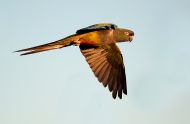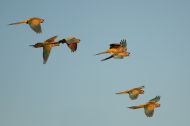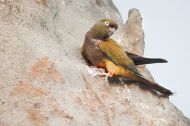Burrowing Parrot
Loro Barranquero
Cyanoliceus patagonus
Length: 460mm. Sexes alike. Bill black; eyelids and naked skin around eye white; iris white with a greyish ring around pupil; feathers covering base of bill where nostrils open black; forehead olivaceous brown; rest of head and hind neck bronzed olive green; sides of head, foreneck and breast olivaceous brown; whitish semicollar on both sides of upper breast. Flanks olivaceous yellow; abdomen and tibial feathers orange red; undertail coverts olivaceous with yellow margins to feathers. Upper back and scapulars olivaceous brown; lower back, rump and uppertail coverts olivaceous yellow; upperside of rectrices olivaceous brown with a bluish tinge, underside of rectrices olivaceous brown. Wing coverts bronzed green; alula, greater coverts of primaries, primaries and secondaries blue; lesser and median underwing coverts and axillaries bronzed green; greater underwing coverts and underside of remiges olivaceous brown. Legs whitish. Juveniles are similar to adults but are duller; the collar is less conspicuous and the bill shows whitish on the upper half of maxilla, from base to tip.
Habitat and behaviour: very common and abundant, this species dwells in open fields both in arid and semiarid regions, in shrubby steppes and small woods. It is found in groups that fly low over the fields. In roosting and breeding grounds they gather in vast flocks. At night they rest in burrows in banks or in trees and their shrieks can be heard all night. At daybreak, they set off to forage in the fields, travelling great distances, always in groups, although not very large ones.
The Burrowing Parrot feeds on seeds, grains, fruits and buds; in areas where there are fruit trees they gather to feed, and in the evening they fly back to roosting grounds, flying low in noisy groups that arrive in succession from all directions.
It nests in burrows in earthen or clay cliffs by the seashore or riverbanks; clutch size is up to four white eggs. Most southern populations migrate in autumn northwards, but some populations remain year-round; in spring time, when they return, they forage the shrubby woodland where food is most abundant and then continue further south, in this case flying at considerable height.
Range: from Neuquén and Río Negro to north of Santa Cruz in Patagonia, where the race Cyanoliceus patagonus patagonus is found; in the north the race Cyanoliceus patagonus andinus occurs up to Salta and eastwards to Córdoba, La Pampa and Buenos Aires. Nevertheless distribution of both races is not totally clear. In Chile the race Cyanoliceus patagonus byroni occurs from Atacama to Valdivia.
Illustrated Handbook of the Birds of Patagonia
Kindless: Kovacs Family
|











